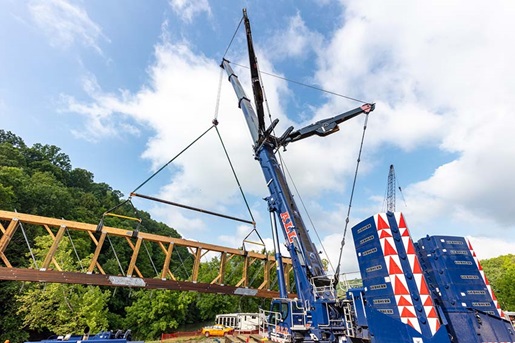
Choosing the right heavy lifting equipment is important, but it’s not always easy to decide which type of machine is the right fit for your job.
All-terrain cranes, truck cranes, and boom trucks all offer different advantages based on project requirements, site conditions, and lifting needs. Let’s examine some of the factors that can affect your decision and some of the key differences between these three types of machines.
The Size of the Machine
All-Terrain Cranes: These are the largest of the three options, both in terms of jobsite footprint and lift capacity. Our all-terrain cranes offer max capacities ranging from 45 to 900 US tons. Many all-terrains have optional attachments including jibs, luffing jibs, and Y-guys/Megawings.
Truck Cranes: While still substantial pieces of equipment, they offer a middle ground between the three options for both lifting capacity and machine size. Our truck cranes have a capacity range of 40 to 140 US tons depending on the model. Truck cranes are often an economical option for HVAC and facility maintenance, due to their roadability and fast setup.
Boom Trucks: These offer the lowest lifting capacity in our fleet at 23 to 50 US tons, making them more budget friendly for the smaller jobs. Boom trucks are essentially cranes mounted on a commercial truck chassis, making them more compact and very customizable.
Tire Size/Axles
All-Terrain Cranes: These machines feature specialized, large-diameter tires designed to allow for ample ground clearance and load distribution for both on and offroad work. They can have upwards of nine axles depending on the model and manufacturer to allow for smooth operation, even with rough terrain.
Truck Cranes: These cranes use a purpose-built truck chassis equipped with standard commercial truck tires. They commonly have three or four axles, with fewer driven axles than AT cranes. The commercial-grade tires are optimized for highway travel depending on the state and are not intended for offroad use.
Boom Trucks: The commercial truck chassis features standard tires and axle configurations similar to vehicles with the same base. The standard chassis design does offer the benefit of reduced maintenance costs and less extensive on-site assembly compared to larger types of heavy lifting equipment.
Maneuverability
All-Terrain Cranes: These machines offer superior maneuverability with multiple steering modes, including crab steering. This level of versatility allows them to navigate challenging jobsites, including tight, awkward spaces or rough terrain like sand and dirt.
Truck Cranes: Truck cranes are often limited to more conventional steering options, although some models may offer rear axle steering for improved turning radius. Despite this, they still offer excellent maneuverability due to their truck-style chassis. This design allows operators to maneuver truck cranes easily on stable ground, driving the crane like a commercial truck while also working the crane from the enclosed cab.
Boom Trucks: As a crane mounted on a commercial truck chassis, these machines drive like regular trucks. This feature makes them very easy to maneuver on paved roads and other spaces where commercial trucks would thrive. These machines also offer a smaller turning radius of the three options due to their compact size, but they do lack the advanced steering modes that all-terrain cranes and other equipment may offer.
Find the Right Crane for Your Specific Heavy Lifting Jobs
There are plenty of cranes to choose from, but the right choice can make a major difference in the overall success of your jobs. ALL Crane’s extensive fleet of cranes and tailored crane service across North America, whether you need an all-terrain crane, truck crane, boom truck, or some other heavy lifting machine.
Need cranes for your lifts? Contact ALL Crane today and discover how we can provide your business with the best, most cost-effective equipment for your needs.
